DeepArt.io

Neural networks are no stranger to the art world. These networks are used in works such as Ralf Baeker’s, Rechnender Raum (Computing Space) (1) and SymbioticA’s MEART – The Semi-Living Artist. (2) Neural networks are essentially programs that mimic the human brain when it comes to problem-solving. In other words, it’s a system or network […]
Metavid
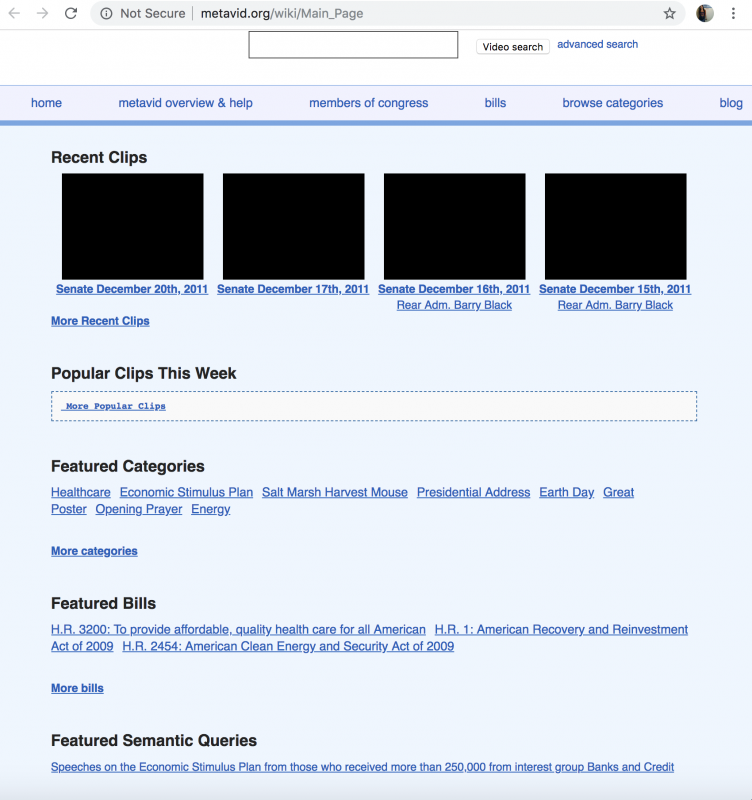
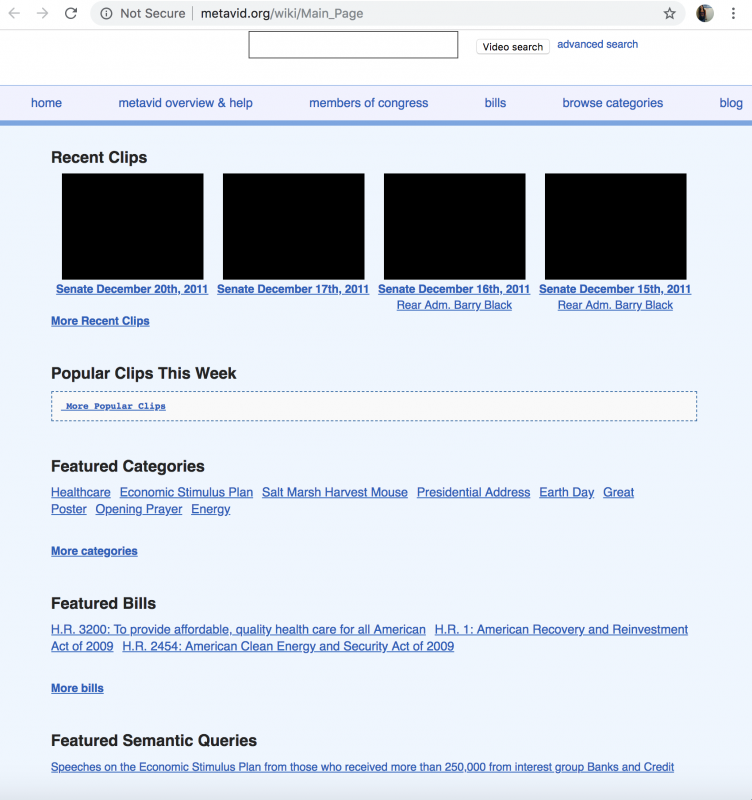 Metavid is a free-software site that hosts United States public domain legislative footage. Through closed-captioning text from a “simple Linux box”[1]that records “everything C-SPAN shoots,”[1] Metavid can provide “brief searchable clips”[1] of legislative footage. Online communities can engage with the audio and video media archives which are not usually viewed by the public but told second hand through other media outlets. Metavid captures a non-bias recording of legislative meetings so that the people can draw their own opinions and ideas. The close-captioned text allows users to quickly and easily search through the thousands of hours of archived footage so that all the related media appears in the search results.
Metavid is a free-software site that hosts United States public domain legislative footage. Through closed-captioning text from a “simple Linux box”[1]that records “everything C-SPAN shoots,”[1] Metavid can provide “brief searchable clips”[1] of legislative footage. Online communities can engage with the audio and video media archives which are not usually viewed by the public but told second hand through other media outlets. Metavid captures a non-bias recording of legislative meetings so that the people can draw their own opinions and ideas. The close-captioned text allows users to quickly and easily search through the thousands of hours of archived footage so that all the related media appears in the search results.
r/place
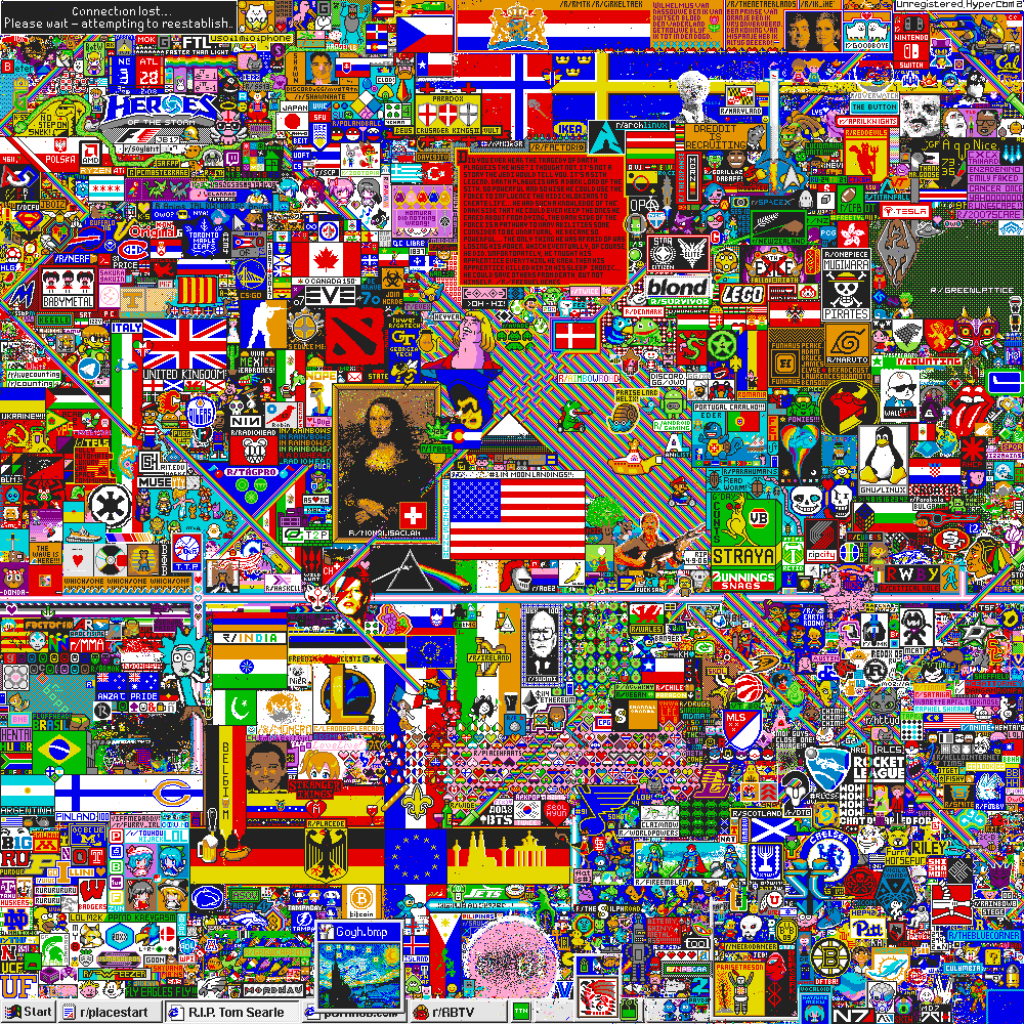
 r/place (pronounced "ar slash place" or simply just "place") is a collaborative art project created by the community of the website Reddit.com in April of 2017. r/place was a grid of one million pixels (1000×1000) that was initially completely white. Anyone with a reddit account could visit http://www.reddit.com/r/place between the first and third of April of 2017. Once there, users could pick a color, and place a single pixel of the chosen color anywhere on the grid, including pixels that other users had already filled in. Users were allowed to place additional pixels five to twenty minutes after each pixel they placed. The page still exists, however users can no longer participate in the project and instead the subreddit is now dedicated to people simply talking about r/place.
r/place (pronounced "ar slash place" or simply just "place") is a collaborative art project created by the community of the website Reddit.com in April of 2017. r/place was a grid of one million pixels (1000×1000) that was initially completely white. Anyone with a reddit account could visit http://www.reddit.com/r/place between the first and third of April of 2017. Once there, users could pick a color, and place a single pixel of the chosen color anywhere on the grid, including pixels that other users had already filled in. Users were allowed to place additional pixels five to twenty minutes after each pixel they placed. The page still exists, however users can no longer participate in the project and instead the subreddit is now dedicated to people simply talking about r/place.
$8,793 Worth of [Digital] Art

 In art critic Pau Waelder's ebook, titled $8,793 Worth of [Digital] Art, he pairs each of the 159 images of works of art lifted directly from the online art marketplace S[edition]'s storefront with either an authentic or unauthentic "certificate of authenticity," which is intended to only be given upon the official purchase of each copy of an art piece by an individual. However, a simple flaw in the website presentation allowed Waelder to reproduce the certificate – a blank example copy for each art piece is shown on the website proper, which Waelder copied and used to forge some of the certificates in his collection while the rest he officially purchased. These copies are indistinguishable from the real deal, forcing the reader to distrust what they see on the page as fact – an obvious metaphor for what debatably constitutes as "owning an official piece of art" in the contemporary digital landscape.
In art critic Pau Waelder's ebook, titled $8,793 Worth of [Digital] Art, he pairs each of the 159 images of works of art lifted directly from the online art marketplace S[edition]'s storefront with either an authentic or unauthentic "certificate of authenticity," which is intended to only be given upon the official purchase of each copy of an art piece by an individual. However, a simple flaw in the website presentation allowed Waelder to reproduce the certificate – a blank example copy for each art piece is shown on the website proper, which Waelder copied and used to forge some of the certificates in his collection while the rest he officially purchased. These copies are indistinguishable from the real deal, forcing the reader to distrust what they see on the page as fact – an obvious metaphor for what debatably constitutes as "owning an official piece of art" in the contemporary digital landscape.
Indeed, if one were to compare this certificate with any featured on S[edition]'s website, can any difference be found? (Save for the art and artists' names, of course.)
Roomba Paintings
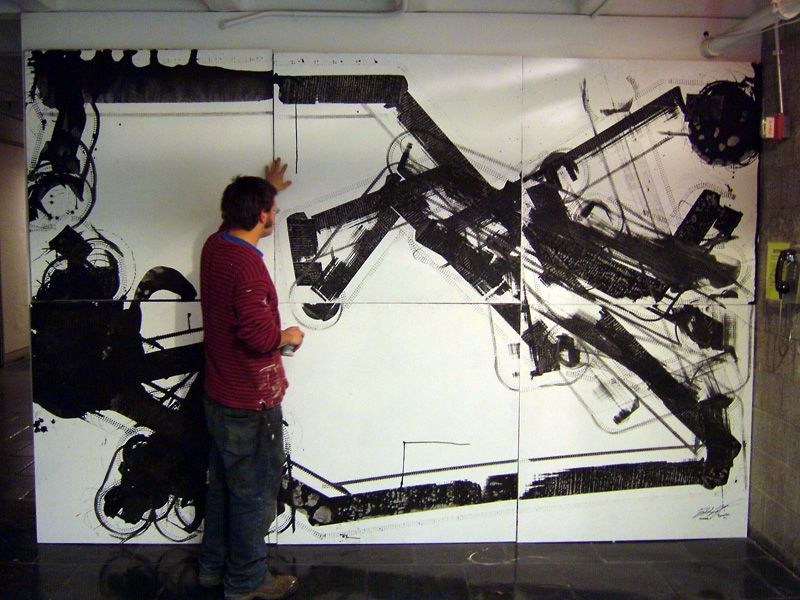
 Roombas, or iRobots, have cleaned our carpets and floors since the 1990s [1] and have been an excellent innovation toward better vacuums ever since. In 2006, sculptor Bobby Zokaites saw more than just a better vacuum, he saw a potential tool to create art. What do you get when you take the vacuum out of the Roomba and add a paintbrush? Roomba Paintings!
Roombas, or iRobots, have cleaned our carpets and floors since the 1990s [1] and have been an excellent innovation toward better vacuums ever since. In 2006, sculptor Bobby Zokaites saw more than just a better vacuum, he saw a potential tool to create art. What do you get when you take the vacuum out of the Roomba and add a paintbrush? Roomba Paintings!
Polarseeds

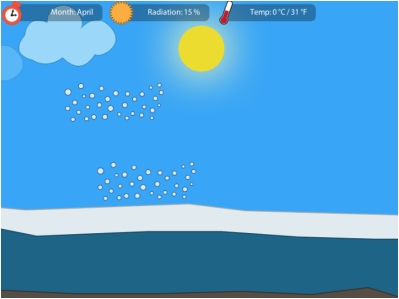 THE POLARSEEDS PROJECT: COMMUNICATING GREENLAND MELTING THROUGH VISUALIZATION AND SONIFICATION. Marco Tedesco, associate professor of earth and atmospheric sciences at the City College of New York, noted the beauty of climate science, such as flooding, cloud structure, and melting ice. To make climate science more attractive, he and his colleagues have jointly developed a research project called "Polarseeds" to present the diverse art of climate science through visual arts, music, and games.
THE POLARSEEDS PROJECT: COMMUNICATING GREENLAND MELTING THROUGH VISUALIZATION AND SONIFICATION. Marco Tedesco, associate professor of earth and atmospheric sciences at the City College of New York, noted the beauty of climate science, such as flooding, cloud structure, and melting ice. To make climate science more attractive, he and his colleagues have jointly developed a research project called "Polarseeds" to present the diverse art of climate science through visual arts, music, and games.
CAPSID
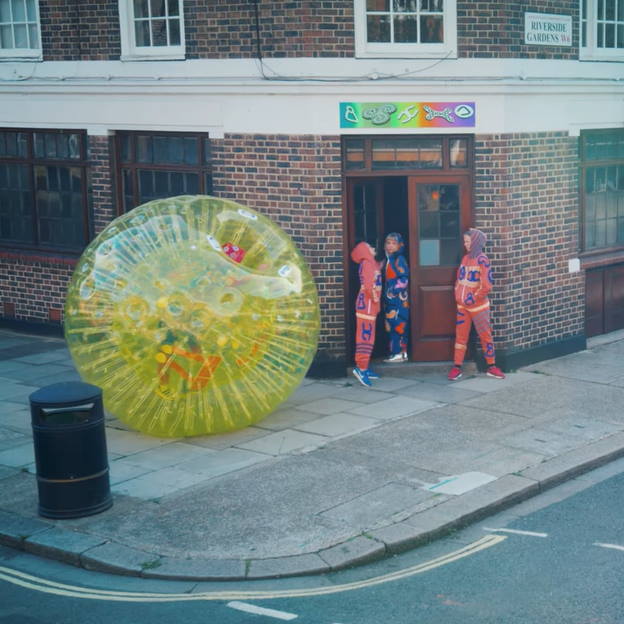
[video src=https://www.youtube.com/watch?v=l8IhFWiri5o]London-based artist John Walter spent three years studying with Greg Towers at UCL to better understand the interactions between a virus and its host, specifically HIV-1 and the effect of AIDS on the human body's immune system. His meticulous research is shown in his new multimedia project CAPSID, featuring a short film titled A Virus Walks Into a Bar, which pulls the "bar" motif of British soap operas to present an analogous tale of how HIV enters human cells and destroys them from within. Through this film – as well as paintings and installations – Walter's work not only uncovers new ways of expressing how HIV behaves, but presents his findings in a way that the non-scientifically-inclined can understand.
Inorganic Flora
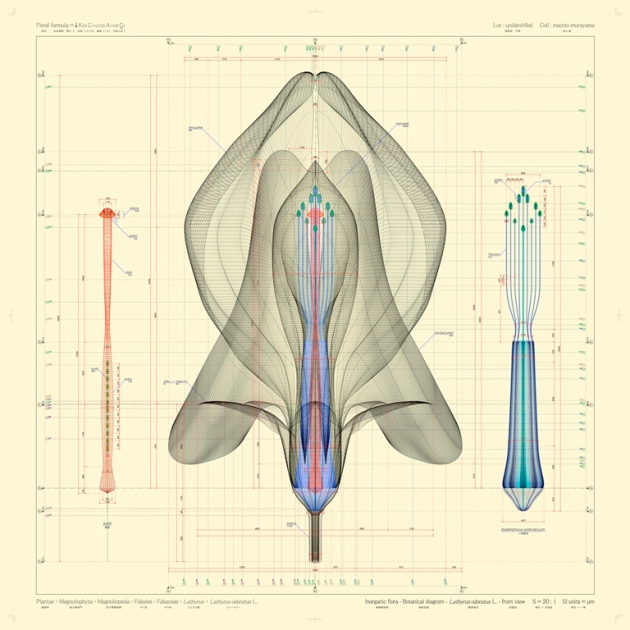
Combining the delicate, intricate folds of nature with the hard, clinical use of computer algorithms, artist Macoto Murayama digitally sculpts flowers that he painstakingly dismantles in order to further understand their structures. Working mostly in Japan, Murayama is a botanist, as well as an artist, who attended Miyagi University in 2007, and went […]
Mechanical Parts

[video src=http://vimeo.com/78771257 align: right height: 220] Mechanical Parts is a series of illustrations drawn by a robot programmed by artist Matthias Dörfelt. His machine, named ‘Robo Fabers,’ rolls across the paper and creates drawings autonomously, while adhering to a set of… interesting guidelines Dörfelt programmed it with. As he told Gizmodo, “basically [Robo Fabers] is doodling connectors—think of it as robot genitalia—as a first step of planing reproduction.” The machine randomly arranges various permutations of components as specified by Dörfelt. Most noticeably, shapes clearly resembling hairy and shorn testicles, phalluses, sperm, holes, and eggs are are visible in the drawings pictured above.
Hello World! Or: How I Learned to Stop Listening and Love the Noise

 Hello World! is a large-scale audio visual installation comprised of thousands of unique video diaries gathered from the internet. The project is a meditation on the contemporary plight of democratic, participative media and the fundamental human desire to be heard. Hello World is the first program that is traditionally taught in any programming language, and How I Learned to Stop Listening and Love the Noise references the Stanley Kubrick film Dr. Strangelove. The installation tries to capture the vast archive of one-person narratives that exist on the Internet and emphasize them as a collective whole rather than as individuals.
Hello World! is a large-scale audio visual installation comprised of thousands of unique video diaries gathered from the internet. The project is a meditation on the contemporary plight of democratic, participative media and the fundamental human desire to be heard. Hello World is the first program that is traditionally taught in any programming language, and How I Learned to Stop Listening and Love the Noise references the Stanley Kubrick film Dr. Strangelove. The installation tries to capture the vast archive of one-person narratives that exist on the Internet and emphasize them as a collective whole rather than as individuals.
The Physiognomic Scrutinizer

Surveillance and physical stereotyping easily go hand in hand together when explored in the context of software. Programs require fundamental placeholders for values and measurements, and to describe a person using these universal traits requires a very cold and objective approach. In 2010, the annual STRP festival in the Netherlands witnessed a new take […]
Dialtones Telesymphony

Dialtones, produced in 2001 by artist Golan Levin, is a musical ensemble of participant’s cellphones that is much like an auditorium-style concert. This work of art has played in many places, including its debut at the Ars Electronica Festival (Linz, Austria) in 2001 [1]. The performance is put on by a group of people, such […]
The Deleted City

In 2011, Richard Vijgen created The Deleted City. It is an interactive piece that uses the 650-gigabyte backup of Geocities. Geocities was a free webhosting provider that was set up like a city, where users were free to upload information about a topic of their choosing. Users were provided with a “free piece of land” […]
The Internet Mapping Project

If one could actually see and visualize the virtual Internet world, what would it look like? According to the results of the Internet Mapping Project, the online web appears to be much like a complex tree of many overlapping and connecting branches. The Internet Mapping Project is a colorful digital artwork created by computer scientist […]
Kelly Heaton : Reflection Loop
Kelly Heaton : Reflection Loop (1972) Software designer Steve Gray and artist Kelly Heaton created a very unique experience with children’s old toys, called the Reflection Loop: The pool. [1] Heaton became very familiar with analog electrical engineering in the late 90’s, which ignited the spark to creating the remainder of her work. The way […]
“The Mandelbrot Set” Benoit Mandelbrot

The Mandelbrot Set by Benoit Mandelbrot is a fractal that employs the simple equation “z = z *z + c”. This equation basically controls a feedback loop. “The equation is calculated dozens, or even millions of times for each pixel. Each time through the loop, the result of one calculation is used as the input […]
Allvision
A better article on Allvision is here Allvision – Marita Steina (1976) Before inventing Allvision, Marita Steina studied art and music in Prague, Czechoslovakia. As she was studying these various art forms, she met her husband, Woody, who was very skilled in videography and electronic connectivity. Around 1975, Marita became extremely fascinated with technology of […]
Faraday Cage
In the early 1970s, Tom Sherman’s work focused on the form and definition of sculpture. In 1973, Sherman became very interested in radio waves and how they interact with each other and with humans. [1] As his facination with radios grew, he decided that he wanted to build a “shelter” or a “radio-free” environment to […]
Joseph Kosuth’s Five Words
Five Words in Blue Neon by Joseph Kosuth FIVE WORDS IN BLUE NEON (above image) is the exact description of what this work displays. This glorious, florescent glow of blue neon spelling the simple phrase “FIVE WORDS IN BLUE NEON” contains a particular aura in what this work portrays.[1] With the work displayed […]
Compressionism

 Part photography, part performance art filtered through an algorithmic structure, Nathaniel Stern's Compressionism uses a document scanner as the tool of choice, which takes on the dual roles of paintbrush and camera: as the scanner bulb moves along its path, the artist follows his own path hovering over various objects and textures. Sometimes linearly, sometimes erratically, he moves according to his own performative instincts. With this kinetic approach, Stern bridges a certain gap between his body and the end result.
Part photography, part performance art filtered through an algorithmic structure, Nathaniel Stern's Compressionism uses a document scanner as the tool of choice, which takes on the dual roles of paintbrush and camera: as the scanner bulb moves along its path, the artist follows his own path hovering over various objects and textures. Sometimes linearly, sometimes erratically, he moves according to his own performative instincts. With this kinetic approach, Stern bridges a certain gap between his body and the end result.
Despondency Index
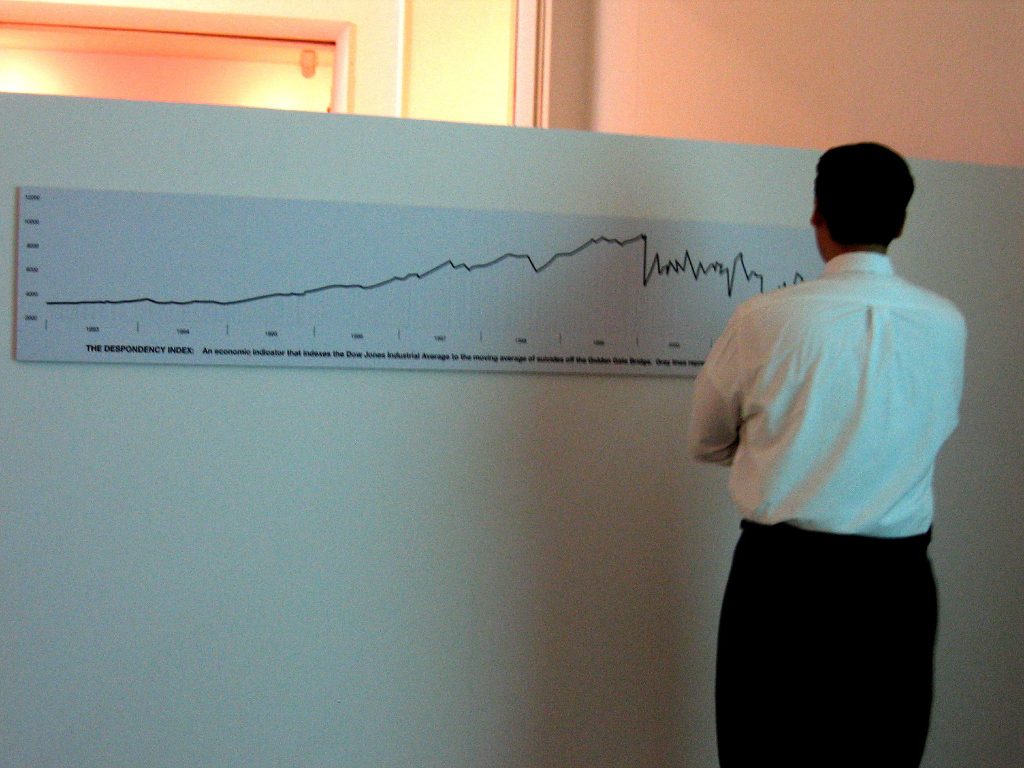


A Season in Hell



Hydrospatial City
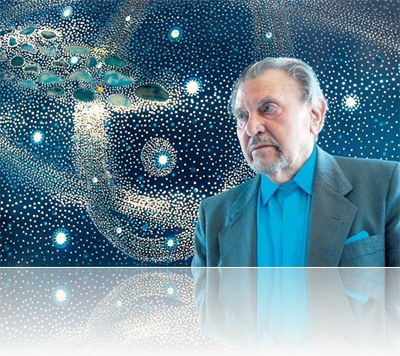

Random Screen

Random Screen is a mechanical thermodynamic screen that the user can’t control and that functions without any electricity. Conventional tea candles illuminate and generate the changes on the 5×5 pixel screen. (early version 4×4) This work is one of a series of low-tech screen projects that was originally inspired by the Blinkenlights media façade of […]
Microcosm

[video src=http://www.youtube.com/watch?v=1NneEvC18cs align:right]Miao Xiachun’s recent work transforms paintings from the canon of Western art history into photographic and animated computer models. Microcosm is based on Hieronymus Bosch’s 15th century masterpiece The Garden of Earthly Delights.
Kino-Automat

 Billed as “the world’s first interactive movie,” Kino-Automat was shown in a specially-built theater in the Czech Pavillion at Expo ’67 in Montreal.
Billed as “the world’s first interactive movie,” Kino-Automat was shown in a specially-built theater in the Czech Pavillion at Expo ’67 in Montreal.
Cubic Limit series, P-154c
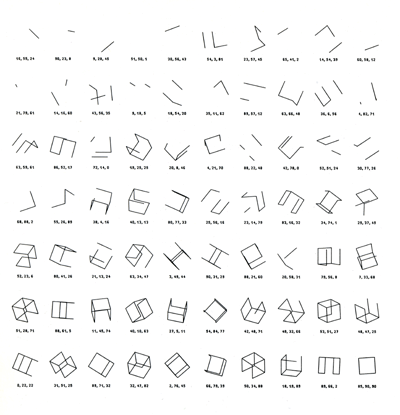
In Cubic Limit, Manfred Mohr introduced the cube into his work as a “fixed system with which signs are generated. In the first part of this work phase (1972-76), an alphabet of signs is created from the twelve lines of a cube. In some works, statistics and rotation are used in the algorithm to generate signs. […]
Continuel – Lumiere – Cylinder

According to artist Julio LeParc, a member of GRAV in Paris, our “first experiments with light were conducted in 1959: We place the light in small boxes which reproduced, multiplied and combined with the screens made of Plexiglas slates, prisms, squares and circle shapes, using a scale of 14 colours. Like in other experiments it […]
Homage to New York


Cloud Canyon, Cloud Fruits


Pirates of the Amazon
 [video src=http://vimeo.com/2380513]
[video src=http://vimeo.com/2380513]
Virtual Mirror – Rain
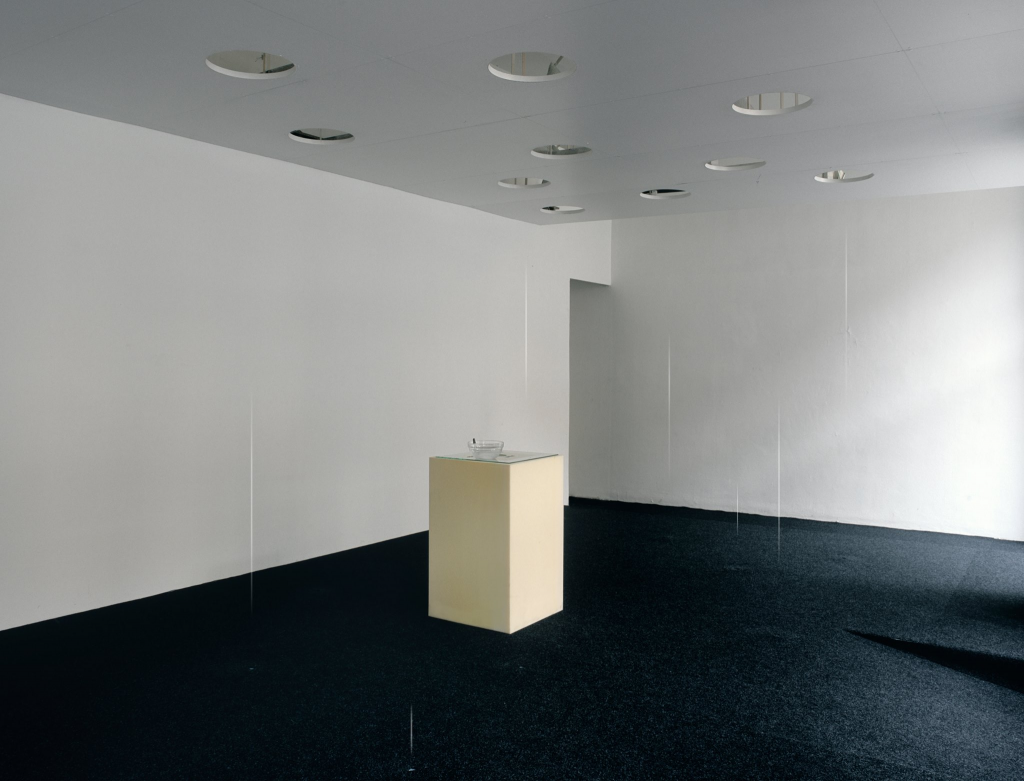 [video src=http://vimeo.com/10002754 align:right height:220]
[video src=http://vimeo.com/10002754 align:right height:220]
Artist Tao Sambolec's expanded conception of art emphasizes tactility, embodied experience, affect and perception in space, often involving displacements that heighten our sensory awareness. In this respect, his work finds good company with pioneering contemporary artists from Duchamp to Eliasson. A case in point is Virtual Mirror – Rain, which received Honorable Mention at Prix Ars Electronica. The artist has somehow managed to achieve what might at first seem impossible: rain falling from the skies outside the gallery triggers an equivalent amount of rain "falling up" inside the gallery!
Remembrancer
 [video src=http://vimeo.com/6855035]
[video src=http://vimeo.com/6855035]
From the artist’s website:
TODAY, TOO, I EXPERIENCED SOMETHING I HOPE TO UNDERSTAND IN A FEW DAYS
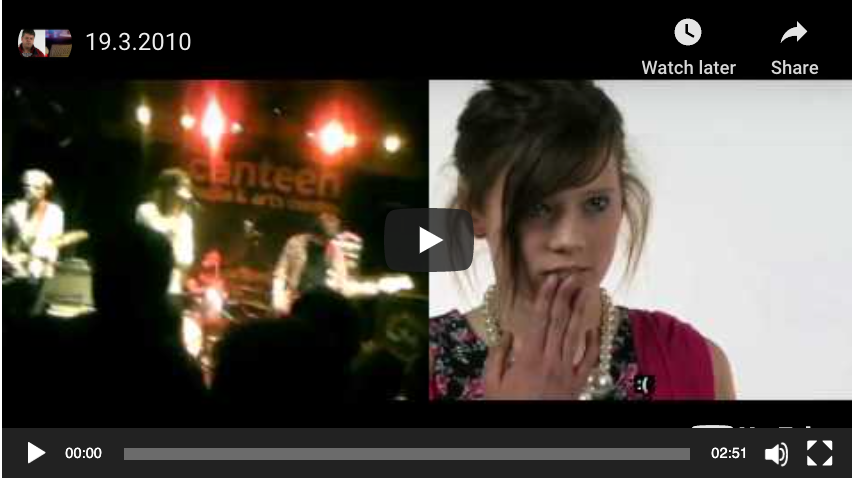 [video src=http://www.youtube.com/watch?v=di3ABJwQO24&feature=player_embedded]
[video src=http://www.youtube.com/watch?v=di3ABJwQO24&feature=player_embedded]
From the artist’s website
Sheng High
 [video src=http://www.youtube.com/watch?v=kjmeOnyQ5Pk]
[video src=http://www.youtube.com/watch?v=kjmeOnyQ5Pk]
Sheng High is the creation of kinetic sculptor, sound artist, musician and composer Trimpin (1951).
Face Visualizer
 [video src= http://www.youtube.com/watch?v=pLAma-lrJRM&feature=player_embedded#]
[video src= http://www.youtube.com/watch?v=pLAma-lrJRM&feature=player_embedded#]
Ocean Without a Shore
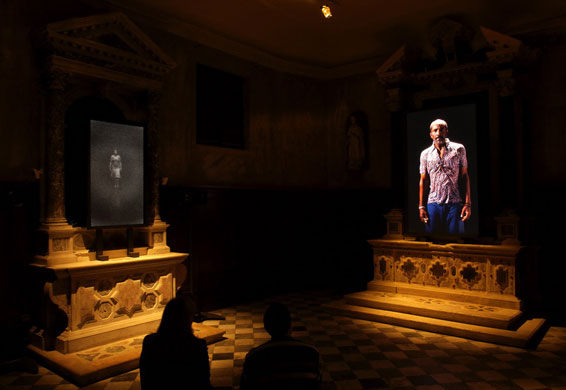 [video src=http://www.youtube.com/watch?v=eTakwOpWqG4&feature=related]
[video src=http://www.youtube.com/watch?v=eTakwOpWqG4&feature=related]
Peepshow
 [video src=http://www.youtube.com/watch?v=xjS-cMn8GQQ]
[video src=http://www.youtube.com/watch?v=xjS-cMn8GQQ]
Cybernetic Bacteria 2.0
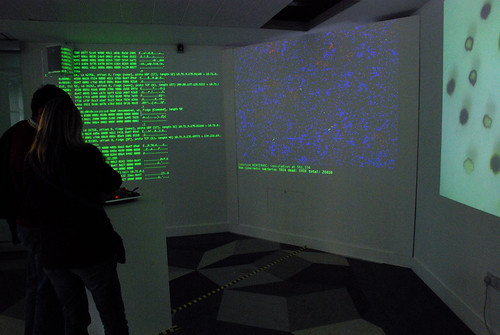
[video src=http://www.youtube.com/watch?v=XQTdvvVH-kk]
La Princesse
 [video src=http://www.youtube.com/watch?v=fqolwulVlsc]
[video src=http://www.youtube.com/watch?v=fqolwulVlsc]
